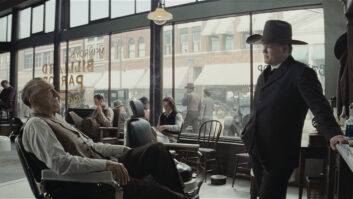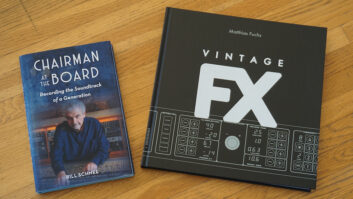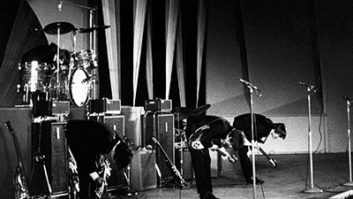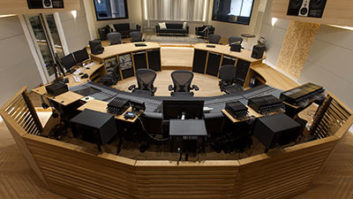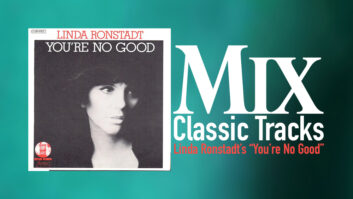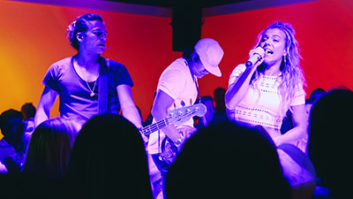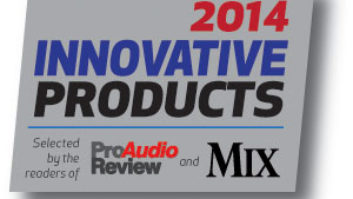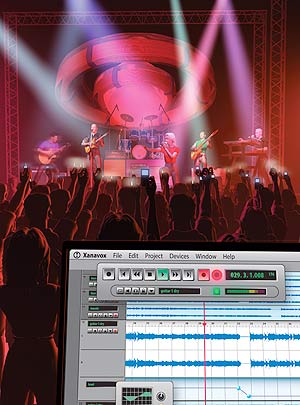

There’s a perfect storm in live sound recording technology: the power of computers combined with the ease and portability of digital recording gear have made it easier to record on the road. And on top of that, the ability to disseminate those recordings quickly on the Web benefits the entire chain — all the way from producer to consumer.
We’ve been spoiled by the convenience technology has afforded us in the past 10 years, but it wasn’t so long ago that recording on tour was an expensive proposition: You had to hire a full-fledged remote truck and hope that you captured what you needed in a night or two. This scenario made live recording rare and expensive, and to support it you needed to produce a highly sellable product to recoup cash. Now, the fact that rigs are portable and integrated directly into the front-of-house position across a range of live sound mixing products makes the prospect of recording every night both affordable and essential to the modern live engineer’s touring routine.
Illustration: Chuck Dahmer
In this feature, we won’t be focusing on how remote trucks integrate into live recording — that’s a whole other topic. What we will discuss is how new live recording methods have changed the way live sound professionals work and how the technology applies to setup, soundcheck, release for broadcast, DVD and CD.
THE EVOLUTION OF LIVE RECORDING
Live recording started to depart from the remote truck model slowly, beginning around 15 years ago with the advent of Modular Digital Multitrack (MDM) recorders such as the Alesis ADAT and Tascam DA-88. Early adopting sound reinforcement engineers wanting to record nightly found these devices far from roadworthy and were frustrated by their idiosyncratic operation. Yes, these early and groundbreaking devices were both affordable and portable, but the fragility of the tape-based format and “iffy” synchronization resulted in as many failed attempts as usable takes. Because track counts needed to be high, it took a stack of MDMs to make a single pass, and it wasn’t unusual for tapes to be eaten and/or units to stop and drop out of record, leaving you with a hole in your take.
As with all things promising and new, despite the problems the push was on to improve technology and make things work better. Enter the DAW, laptop and digital console. This technological trifecta has changed the face of audio, both in the studio and in live recording, affording engineers the ability to record reliably, cheaply and easily almost anywhere. This affordability and ease of use have inspired a new model of release and distribution. You can now produce product at the venue and mix it for later release.
The concept was first tried by bands like The Pixies, who in 2005 released 1,000 units onsite at their concerts and more later from their Website. The model was picked up by the classical world when in February of 2006, Sir John Eliot Gardiner and the English Baroque Soloists released what became the fastest classical CD release of Mozart’s Symphonies No.s 39 and 41, available to patrons as they left the concert. Another popular model involves archiving concerts and releasing them via the Web at a later date. Artists such as Bruce Hornsby, Metallica, Amy Winehouse, James Blunt, Little Feat and the Allman Brothers have jumped on this bandwagon, offering live concert recordings dating back to 2002 on sites like munckmusic.com, LiveMetallica.com or iTunes live. And for local bands, there’s monkrat.com, which offers a free system to sell your digital downloads.
Of course, the ability to support the back end with an easy-to-implement distribution model is just one part of the formula. The key is the quality and quantity of the material available. In this regard, the new tech improves on the “truck” model tenfold: In the past, you’d pick from a select few nights of recordings. Now, you gather audio from nightly recordings, ensuring a much larger pool of performances from which to choose. Also, when you’re recording nightly, the band won’t suffer from “red light fever” when the truck shows up. Longtime FOH engineer Robert Scovill (Rush, Tom Petty & The Heartbreakers) says it best: “There’s an advantage to being able to record a lot of shows. I don’t care who the artist is or if they’ve been around for 20 years; the night that the recording truck shows up, they become a different band.” The pressure to perform perfectly is enhanced greatly when you know there’s someone in the parking lot in a truck whom you’re paying to record every move you make — but the impact is greatly reduced if recording is commonplace.
VIRTUAL SOUNDCHECK
Tuning the system and wringing out any difficulties prior to the show is an essential part of the lives of touring pros. Traditionally, the drill has been for the band to show up after load-in and run through a few tunes before taking off for dinner and getting ready for that night’s performance. The downside is that the band is not at its best and is playing full-throttle right after getting off the bus after traveling all night from the previous gig. Enter the virtual soundcheck, the ability to play an actual multitrack performance through the console and tune up the system that way. The advantage is having a fresh, full-powered “performance” from the previous night, bringing energy to the rig that a pre-show band performance cannot. The best possible way to set up this scenario is to have the P.A. “not know” if the feed is coming from mics or the recording, so it is critical to split the signal to the recorder in the proper spot.
In the past, the split would come from a direct output or an insert send. The problem is that this feed was post-preamp and -highpass filter, so if you had to adjust those processes during playback, that signal went to print. For a clean recording that exactly matches what you’re getting from the stage, you don’t want to print any post-preamp processing.
Newer live digital consoles have addressed these issues, but manufacturers differ on how they achieve a solution. An array of desks, including the Digidesign VENUE, DiGiCo D1/D5, Yamaha PM1D/PM5D and Soundcraft Vi Series consoles allow you to tap from a number of points, including directly after the preamp/digital conversion. This way, when playing back from the recorder you can control the entire channel strip and the console feels exactly like the mics are online. Digidesign’s VENUE uniquely addresses the soundcheck model in their design by allowing the user to trim the level of a playback track with the preamp gain knob, and then automatically apply those changes back to the mic pre’s when the mics come back online.
Another advantage of having a multichannel recording on hand to play back throughout the system is testing the cue system to the talent. Bernie Becker, an engineer who has recorded live since 1977 and has worked with Neil Diamond since 1989, uses this setup to check the feeds to the stage’s four discrete Aviom multichannel headphone systems before the 15 players in the band even arrive. His setup starts with 100 channels of Yamaha’s HR mic preamps onstage, which is sent to a Yamaha DME64N router, which splits to two PM5D consoles and a Pro Tools system. The recorder gets the feed directly from the DME64N right after the preamp. With the push of a button, he can feed the entire system from Pro Tools instead of the mics from the stage and check every headphone feed.
RECORDING THE ROOM
Some of the most challenging things to capture live are good ambience and crowd recordings. These elements are best viewed as two separate tasks. According to Scovill, “I try to find some audience hot spots where you have little P.A. or backline sound in the track, which will smear your mix. You have to pay very close attention to the off-axis response of the microphone and where they’re placed in regard to the P.A. system.” At the other end, when trying to record ambience of the room, you want your mics to have some of the P.A.
“I’m using the Holophone H3-D to capture the crowd at front of house,” says FOH engineer Eddie Mapp (Evanescence, P.O.D., Zakk Wylde). Because the mic’s position is 80 to 90 feet back from the stage, when he’s mixing the tracks Mapp slides the Holophone up in time and lines it up with the loudest thing from the stage. This negates the 80- or 90ms delay created by the mic’s placement. “It cleans it up and gives me a more realistic idea of what’s going on in the room,” he says.
Sometimes the band is actually playing back in surround in the venue, which brings another dimension not only to the live mix, but also for recording. “On some of the Rush recordings,” Scovill recalls, “we had microphones hanging from the surround speakers in the back of the room. I had them on microphone positioners, where you could move them remotely, both laterally and vertically.” Scovill would solo these mics during the opening act and move them using the positioner until he got the sound he wanted. Using directional mics for this is important. “I’d get some back-corner ambience using shotguns that would isolate it from the band into the corners of the venue,” he adds. “This would put the listener where I was sitting.”
Becker uses precise mic placement to keep his audience mics in phase. “We’ll use the front of the stage as an imaginary plane,” he explains. “I’ve used boundary mics to get the first five rows and we’ll put up shotgun mics to pick up the far-away audience and point it in different directions to get the ambience of the crowd. Within reason, no matter where the mics are pointing, all the sound arrives at the mics at the same time.”
IN THE CAN — NIGHTLY
There’s no question that the line between the worlds of live sound and recording is quickly becoming nonexistent. The use of multichannel recordings at FOH has made the engineer’s job more efficient, bringing better results from the soundcheck, setup and his/her ability to archive a band’s body of work.
What does the future hold? Perhaps live mixing offsite via the Internet? With the live sound desk as the capture device, engineers could send tracks offsite, have a mixer in a studio work the mix and then send it back to the venue where it would be processed on a mirror system and distributed onsite. It will be interesting to see how the technology develops and how it changes all of our jobs.
Kevin Becka is Mix‘s technical editor.
Another Approach
QUICK AND DIRTY, HD-STYLE
One of the goals of this feature is to give different live recording perspectives, and we couldn’t leave out the quick-and-dirty approach. In truth, sometimes in a small club setting where space is dear and budgets are small, capturing the band using a two-mic approach is just the ticket. To see how we could accomplish this at the highest possible sampling rate, we dispatched engineer Brandon Hickey to the Wise Fools pub in Chicago to record the Gunslinger’s Dream band using the Korg MR1000 stereo recorder and a RØDE NT4 microphone. The RØDE is a great choice for low-profile situations where space is tight because it offers two coincident capsules in the footprint of one microphone that can be placed on a single stand. The venue seats 300 people in a room where ceilings are 25 feet high and FOH position is 40 feet from the stage, which is where the mics were parked at eye level.
The mics were plugged directly into the Korg, which was set at the highest possible sampling rate: 1-bit, 5.6MHz. The Korg supplied the phantom power directly from the battery, which got through the 1-hour, 45-minute show with juice to spare. As “insurance” for overs, Hickey used the onboard limiter but pulled the level back, never hitting the unit harder than -6 dBfs. At this level, the limiters were only in evidence during surprisingly high-SPL situations, always a possibility in a small venue.
The nice thing about the format is that it is already supported by software such as SonicStage Mastering Studio Version 2, DSD Direct and Korg’s AudioGate software for Mac and PC. AudioGate can convert 1-bit recordings into WAV and AIFF formats at various bit rates (and vice versa) and offers real-time conversion and playback of 1-bit files using your computer’s audio hardware. It also does essential functions like DC offset removal, gain control and fade in/out. (You can hear a knocked down version of the recording at mixonline.com’s “Mixed Media” page.) The knockdown is in real time, and no matter what resolution your soundcard allows the software will let you monitor at the highest level during editing because you listen straight off the hard drive of the MR1000 while editing.
— Kevin Becka

The recording gear included a laptop running Pro Tools through a modified Digidesign 002 Rack.
K.I.S.S.

AEA R84 DJV mics in a Blumlein pair
RECORDING THE UCLA MARCHING BAND
Recording engineer, forensic audio expert and ribbon mic manufacturer Wes Dooley has been recording remotely since the early 1960s. He’s schlepped gear to such remote places as Zambia and New Zealand, so he knows the importance of traveling light and getting it right when recording in the field. A week before Thanksgiving last year, he recorded the 250-piece UCLA Marching Band in windy conditions 100 yards from Sunset Boulevard at rush hour — a challenge that he tackled with just five mics. Dooley’s rig started with a Digidesign 002 Rack modded by Black Lion Audio. The company has provided upgrades for the rigs of engineer/author Ron Streicher and engineer Jeff Peters, who told Dooley about the mod. Black Lion upgrades the 002 (rack or console) clock, power supply, analog stages and mic preamps, essentially giving you a new unit that is portable and in a format that is ubiquitous and compatible with Pro Tools. For a backup, Dooley brought along a Tascam DA-88.
The mics were split at line-level right out of the preamps to the 002 recording at 24-bit/44.1kHz, with the Tascam operating at 16-bit/44.1kHz. The preamps were Dooley’s AEA TRP ribbon mic preamps for the R84s and a Soundcraft Spirit Protracker for the condenser microphones. The mics were split into two distinct rigs flown high above the field 20 feet above ground and just behind the conductor, who was 30 feet back from the front of the band. The band was set in an arc focusing themselves at the raised podium, prompting Dooley to use a Decca Tree configuration for one perspective; for a second option, a stereo pair of near-coincident ribbon mics were set in a Blumlein pair. For the Tree, which was suspended on AEA 27-foot stands, he employed three Schoeps CMC6 bodies fitted with MK2H capsules; for the Blumlein, he used a pair of AEA R84 DJV mics developed with an acoustical highpass filter for users who want to employ it at close proximity or in windy conditions. To help alleviate any problems from the blustery weather, the Schoeps mics were fitted with Shure A81WS windscreens while the DJV mics’ internal HPF offered the needed help electronically.
— Kevin Becka
IN THE BOARD
GETTING IT THERE AND RECORDING IT
We sampled a group of live digital consoles to find out how they transport and record a large number of channels of audio. Yamaha’s digital live consoles use the company’s proprietary MY cards to transport audio in formats including analog, AES, ADAT, TDIF, MADI, Ethersound and CobraNet. For recording, the company has created a turnkey recording device with ADK Computer called LyveTracker, which runs Cubase or Nuendo software and has optional interfaces for MADI, AES, ADAT or Ethersound. LyveTracker is capable of recording 192 simultaneous tracks.
Digidesign’s VENUE allows you to record or play back up to 128 channels of audio using the console as the interface via two optional HDx cards interfaced to a Pro Tools HD system.
DiGiCo’s consoles use RME’s MADI card to make 160-channel recordings compatible with Pro Tools, Nuendo, Cubase, Logic and Pyramix. To get MADI into Pro Tools, the company recommends the Soundscape iBox MADI2-HD2 converter that takes the place of the HD interface.
Soundcraft’s Vi4 and Vi6 come with an optical MADI card as standard, offering 64 channels of I/O in addition to the stagebox connection. The company also recommends the RME MADI card and Soundscape iBox to record tracks to virtually any DAW.
Roland’s M-400 V Mixing System can record in stereo locally via a USB Memory Drive (8 GB equals 10 hours) or can transport up to 32 channels and eight buses over Cat-5 cable to a Gigabit port on a PC to record on Cakewalk’s SONAR. Cakewalk has written a custom driver supporting Roland’s REAC Ethernet audio protocol.
— Kevin Becka

READ:
More information on “Recording the Band”
Related Articles
Mixing Piano
Nov 1, 2007 12:00 PM, By Kevin Becka
Mixing piano, no matter the genre, calls for your creativity as a mixer and the input of the production team as a guide. Creative discussions can center…
Inside Track: Mixing Guitar
Jul 1, 2007 12:00 PM, By Kevin Becka
The words and go hand in hand. Along with a well-conceived and -played part, a well-crafted mix draws the listener in and sells the tune, whether it’s…
Inside Track: Mixing Strings
Sep 1, 2007 12:00 PM, By Kevin Becka
Elton John’s Philadelphia freedom. Diana Ross & the Supremes’ Someday We’ll Be Together. Train’s Drops Of Jupiter. Prince’s Purple Rain. What’s the common…
The Inside Track: Mixing Drums
Jan 1, 2007 12:00 PM, By Kevin Becka
Mix is proud to introduce a new article series for 2007: the Inside Track, a bi-monthly feature by Mix technical editor Kevin Becka that explores the…
The Inside Track: Mixing Vocals
Mar 1, 2007 12:00 PM, By Kevin Becka
A well-mixed and -sung lyric is the emotional centerpiece of any song. But because of the complexity of pitch, tone, nuance and lyrics, vocals need the…
Speech and Song
Nov 1, 2005 12:00 PM, By Kevin Becka
We all know that voice is king. Of the six instrument categories we’ve explored in our Recording the Band series, the voice is arguably the most powerful….
Hellacious Horns
Sep 1, 2005 12:00 PM, By Kevin Becka
English conductor and obvious curmudgeon Sir Thomas Beecham said, Brass bands are all very well in their place outdoors and several miles away. But don’t…
Killer Keys
Jun 1, 2005 12:00 PM, By Kevin Becka
Guitarist Andrs Segovia said, The piano is a monster that screams when you touch its teeth. At the extreme, this is true, as anyone listening to pianist…
Guitar Greatness
Mar 1, 2005 12:00 PM, By Kevin Becka
The guitar has defined generations of music since its rise in popularity in the mid-’50s. Trailblazing players such as Chuck Berry, Jimi Hendrix, Jeff…
Percussive Perfection
Jan 1, 2005 12:00 PM, By Kevin Becka
This feature marks the first installment of Mix’s six-part Recording the Band Series by technical editor Kevin Becka. In these bi-monthly articles, Becka…
